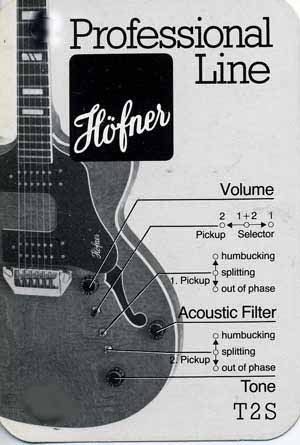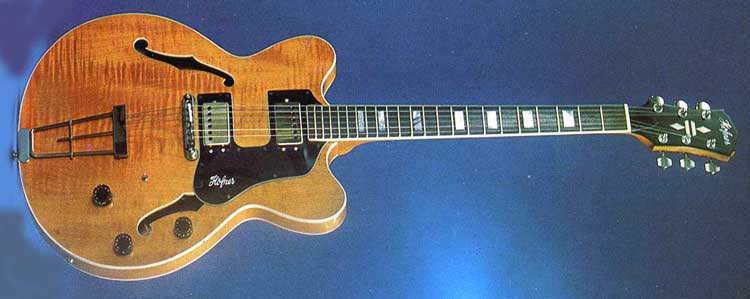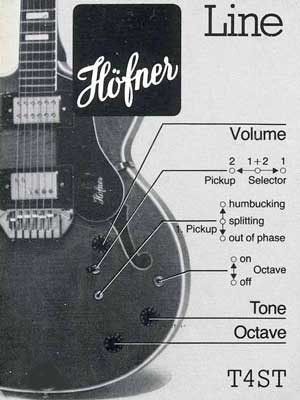

Hӧfner introduced a new range of guitars in 1978,
together with a new style of marketing, the centrepiece of which was the
“Professional Line” catalogue. This 8-page catalogue had a much more modern and
“switched-on” appearance than any of the previous Hӧfner catalogues, helped
somewhat by the cover which displayed a rather seductive young lady cuddling up
to a Hӧfner guitar. The new range however really did live up to the catalogue’s
name as it contained a comprehensive range of professional level guitars, all of
which were brand new models:
·
The Hӧfner A2L
full-bodied archtop
·
The Hӧfner A2HL
thinline archtop
·
The Hӧfner T2S and T2N
semi-acoustics
·
The Hӧfner S5E solid
guitar
·
The Hӧfner S7L solid
guitar
·
The Hӧfner S7-12
twelve-string solid guitar
·
The Hӧfner S7B solid
bass guitar
In addition to the guitars, the catalogue described in
previously un-known detail the new active electronics and pickups types used
throughout the range. Hӧfner were at last coming out of the dark ages!
Gerhilde and Christian Benker had, by 1977, firmly taken
up the reigns of managing the Hӧfner Company from Gerhilde’s father Walter and
her Uncle Josef. The two brothers did still take an active interest in the
workings of the Company during the 1970s; they were always present at the
annual Music Trade Fair at Frankfurt for example. However, in 1970, Josef was 78
years old and in that year he took retirement - in theory if not in total
practice. Walter was 68 in 1970 and still working flat out. However, both men
understood that it was now approaching the time when their burden should be
passed on, and so the start of the new decade heralded the much increased
dependence on Gerhilde and Christian.

The new company managing directors must have realised
that they just could not rely on Walter Hӧfner’s still popular but dated guitar
designs, together with some rather blatant copies of US-guitars, in order to
keep the company running. They therefore turned to a German professional
guitarist called Gela Hildebrand to inject a modern approach to guitar design,
with a brief that the new models should be top-quality professional models that
would compete on equal terms with anything that was coming out of America.
Hildebrand obviously realised Hӧfner’s strengths and
weaknesses. The company’s talents with wood, together with of course Walter’s
inspired design work, had kept it in front of the rest since Walter and Josef
had started back in business in the late 1940’s, and that level of craftsmanship
was still there. Where Hӧfner did have a problem in particular was in their
guitar’s electrical fittings, the design of which had not progressed very much
since the 1950’s, as well as the fact that in a rapidly changing market, the
overall design concept of some the guitars was looking dated.
All this excitement about the new guitars shouldn’t be
construed as marking the end of all the old Hӧfner models however. As far as
archtops were concerned, Hӧfner continued to offer some of their old favourites.
The 457, 463, 470, and 477 models, together with their thinline equivalents the
4570, 4577, and 4700 remained in the price lists into the early & mid 1990’s,
hence continuing Hӧfner’s old policy of providing an archtop for all or, perhaps
more accurately, most guitarists’ budgets.
As this book is concerned with arch-topped guitars, we
shall only consider the first three models on the above list.
The
A2L combined the luxury of the discontinued 471 model with the single pickup
simplicity of the un-successful 478. It was intended to be a top-quality
jazz-player’s guitar. As such, it received a large 430mm (17”) body with a depth
of 82mm (3¼”), and was fitted with a single floating twin-coil pickup which Hӧfner
referred to as the “Type 052” attached to the end of the neck. This was
complimented by a Hӧfner’s own “acoustic filter” tone control (in addition to a
conventional tone pot) which allowed all frequencies above 1800Hz to pass, but
added more bass into the lower frequencies – hence providing an approximation to
a miked-up acoustic guitar. An option of a piezo-bridge and stereo output could
be supplied to special order
The top of the guitar’s body was laminated spruce, with
highly flamed maple back & sides. Plenty of binding and purfling to the body and
neck was provided, including Hӧfner’s lovely fleur-de-lys inlaid into the lower
part of the body back, just as the old Committee/468 model guitars had been
ornamented. Both rich brown sunburst and natural blonde finishes were offered.
Large block fret-markers were inlaid into the rosewood
fingerboard, and the double fleur-de-lys headstock decoration indicated to the
world that this was one of Hӧfner’s top guitars.
Hӧfner took the opportunity with the A2L (and A2HL) to
introduce a new tailpiece; the first time that they had moved away from the
standard ABM tailpieces that had served them well (and most other Bubenreuth
manufacturers too) since the late 1940’s. This unit provided the facility to
alter the string tension across the bridge to suit an individual’s taste.
This model was produced between 1978 and 1986, and from
1982 it actually ran in parallel with Hӧfner’s ultimate archtop, the AZ model.
The A2L appears to have been quite successful, as examples of these lovely
guitars do appear quite regularly these days.
The thinline version of the A2L used the same neck and a
50mm (2”) deep version of the A2L’s body. The two Type 052 twin-coil pickups
were fitted directly onto the body however, and as well as the “acoustic filter”
tone control, Hӧfner’s newly patented “Multisound” system was also built in to
the electrics. This involved the usual three-way pickup selector switch,
together with a further three-way micro selector switch for each of the two
pickups. This allowed each pickup to be operated in humbucking, out-of-phase, or
split modes, resulting in a rather baffling number of combinations.
The new adjustable-pressure tailpiece, as used on the
A2L, was fitted, and of course all the bling of the full-bodied guitar was also
there.
As with the A2L, the A2HL was a
single cutaway guitar. However, twin body cutaways similar in shape to the
Verithin’s cutaways appeared on at least one A2HL. There are two photographs in
the Hӧfner Company’s archives which shows such a guitar; one showing it being
displayed at the 1981 Frankfurt Music Trade Show, and another formal shot which
has obviously been taken for possible marketing purposes.
This double cutaway variant was fitted with an
adjustable tailpiece bearing the name A2HL, but it doesn’t appear to have had
the Multisound fitted, Also, the un-notched headstock of the guitar bore the Hӧfner
“double diamond” ornamentation, rather than the usual A2HL notched headstock top
with the two fleur-de-lys. I think that we just have to work on the premise that
Hӧfner made up a prototype in order to test the reaction of the buyers attending
the show, and that this reaction mustn’t have been too encouraging.

The
old double Venetian cutaway very thin bodied models based on the
Selmer-distributed Verithin and its twin, the 4574 model, had been cruising
along since 1960 with little change taking place. By 1978, Gela Hildebrand
obviously thought that things needed to be brought up to date. The Hofner T2
model was the result. Two versions were featured in the Professional Line
catalogue: the T2 S and the T2 N, and production of the 4574 and 4575 models
ceased with immediate effect.
Both guitars shared the same body and neck as
each other, with the depth of the semi-acoustic body being increased from the
30mm of the old “Verithin” formula to a more Gibson-like depth of 40mm.
Laminated maple was used for the bodies, with a rosewood fingerboard on a
figured-maple neck. Both were nicely ornamented with mother of pearl block
fingerboard markers and “double diamond” headstock inlays, and both were
finished in a choice of “Walnut Brown”, a fashionable Gibson finish at that
time, or a blonde-like ”Sahara Yellow”. Their differences lay in the way that
they were fitted out for two different styles of music.
The T2 S was obviously intended to be the more rock-orientated guitar, with a solid brass stop-tailpiece, Hӧfner’s hot Type 057 pickups, and the new multi-sound system as described above, together with a rotary acoustic filter control. The complexity of the electrics on this guitar prompted Hӧfner to produce a neat tag to go into the case of each T2S in order to spell out what all the switches actually were intended to achieve:

The T2 N was intended for music of a more gentle nature,
being fitted with the Type 053 pickups which were described as being for
“universal use”, and a trapeze tailpiece. Again, however, the acoustic filter
was fitted, perhaps more appropriately than its fitment to the T2S.

Unfortunately, the T2 designated guitars did not last
long. Although the T2 S remained in the price list until 1980, in 1979 Hӧfner
dropped the T2 N version and announced the introduction of the T4 S to replace
it. The “new” guitar was to all intents and purposes a T2 S, again with a 40mm
deep body, but fitted with a pre-amp. This presumably allowed Hӧfner to now
describe their Multisound system as being “volume compensated”. Oh, and the T4 S
usually (but apparently not always) had covers fitted to previously open Type
057 pickups of the T2 S. Hӧfner had obviously decided that the preference of the
buying public was for a hot rock guitar rather than the more subdued sounds of
the T2 N!
As well as the T4 S (the “S” indicating the standard
version), another even more complex variant was introduced at the same time in
February 1979. This was the T4 S “Twin Sound” or T4 ST. The Twin Sound referred
to a built in octave divider. To quote directly from the catalogue, the T4 ST
was similar to the T4 S:
“but fitted with a special pickup for the two
bass strings and the four treble strings. If desired, the two bass strings can
be lowered by one octave through a built-in octave divider. The other four
strings are not influenced by this operation. But the pickups also can be used
in the normal way.”

The pickup on which this facility was provided was the
bridge unit, one assumes to get the clearest signal for the electronics to
handle, with the neck pickup being a conventional Type 057. Hӧfner’s intention
behind all this was presumably to provide the player with the facility for
playing bass riffs using the thumb along with normal sounds played on the top
four strings with the fingers.
The volume compensated “Multisound” system on the T4ST
was only applied to the neck pickup of course, and an acoustic filter was not
fitted. Again, the case tag supplied with all new Twin Sound guitars provided
pictorial details of all the control functions, and I would suspect that players
new to the Hӧfner T4 ST would need all the help that they could get!
Initially the T4 guitars were produced with two F-holes in the body top, as had been the case with the T2 models. However, within a year, and certainly by 1980, the soundholes were deleted, making the guitar in effect a semi-solid with little acoustic capability. It may be no coincidence that a semi-solid guitar fitted with active electronics and having no sound holes was introduced by the Gibson Company just before this change in 1979 – the Gibson “ES Artist”.
An early example (1979) of the Hӧfner T4 ST, still with F-holes.
The T4 semis lasted for longer than the superseded T2
model, with the T4 ST dropping out of the price lists at the end of 1984, and
the standard T4 S disappearing a year later in order to make way for Hӧfner’s
ultimate semi, the Nightingale.
The Frankfurt Trade Show of
Spring 1980 saw the introduction of the final “T”-model; the Hӧfner T6 S. This
followed the trend for no soundholes, but the body width was reduced down to
30mm from the T2 and T4 depth of 40mm. Hӧfner had obviously been persuaded by
supporters of the old Verithin/4574 model to re-introduce this body size for a
semi-acoustic/solid guitar, only a year after the 4574 had been discontinued.

The standard pickup set-up of
the T6 S was a single coil unit in the neck position (described in Hӧfner’s
sales literature as an “original
single coil from 1962”) and a twin coil
humbucker at the bridge. These pickups were probably Schaller-made, but DiMarzio
units were also offered as an option. A single volume control was provided,
together with a middle and treble control working on the active pre-amp.
The amount of bling on the T6 S was significantly less
than on the T4 models, with only the Hӧfner logo ornamenting the headstock,
simple dot instead of mother of pearl block markers, and modest (by Hӧfner
standards) binding/purfling around the body edges. This and the simpler
electronics made the DM 1383 price of the T6 S in January 1981 substantially
cheaper than the DM 1607 charged for a T4 S and DM 1776 for the T4 ST. The Hӧfner
T6 S was obviously intended to be the professional musician’s working guitar.
Production of the last two available “T”-Model semis,
the T4 S and T6 S, came to an abrupt halt at the end of 1985 after a
surprisingly successful production run for such unusual all-singing-all-dancing
guitars. Most guitar players are very conservative in their choice of
instruments however, and tend to gravitate to the well-proven and familiar
models. It is still the case that the best-selling models are those designed in
the 1950s. Hӧfner were now in the process of reverting back to the less
futuristic and more traditional approach to guitar making!
__________________________________________________
All Text is Copyright
© 2022 Steve Russell. All Rights Reserved